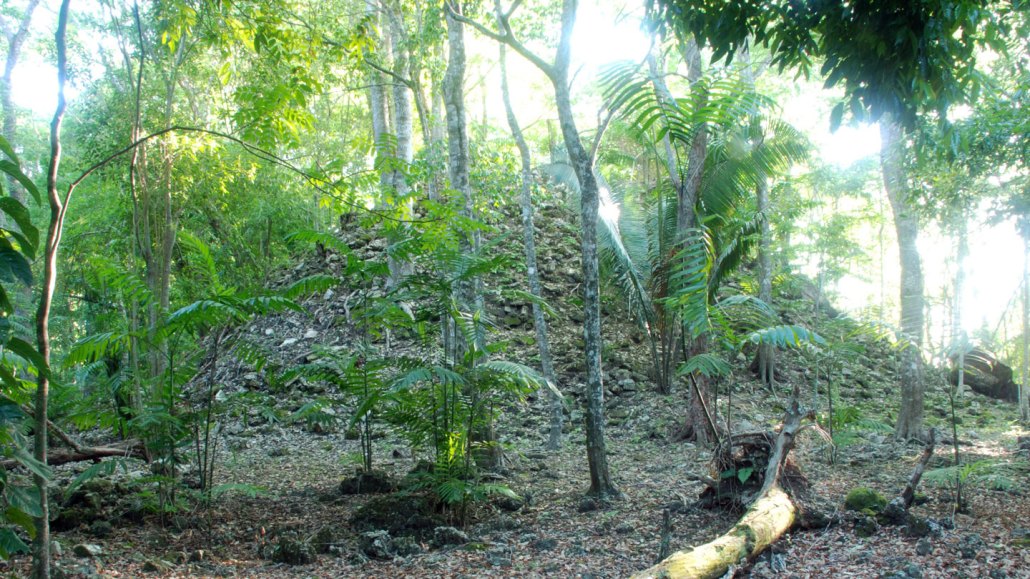Some Maya rulers may have taken generations to attract subjects
Leaders had to negotiate with followers and legitimize their authority, researchers suspect

Remnants of a pyramid that was part of a ceremonial center built around the time of the founding of a Maya site called Tamarindito now lie among trees and other forest growth.
M. Eberl
Commoners may have played an unappreciated part in the rise of an ancient Maya royal dynasty.
Self-described “divine lords” at a Maya site called Tamarindito in what’s now Guatemala left glowing hieroglyphic tributes to themselves as heads of a powerful “Foliated Scroll” dynasty.
But new findings indicate that the bigwigs at Tamarindito spent many generations waiting for their subjects to show up, or perhaps hatching plans to attract followers, say archaeologist and epigrapher Markus Eberl of Vanderbilt University in Nashville and colleagues.
Tamarindito’s kings founded their capital by about the year 400 as a mere hamlet of perhaps a few dozen individuals, consisting of a royal court and a couple of residential clusters for non-elites, the scientists report November 4 in Latin American Antiquity.
It took about 150 years for enough people to trickle in to Tamarindito to enable the site’s rulers to expand their power, Eberl says. At that point, Foliated Scroll rulers founded a smaller, second capital and several other settlements in northern Guatemala. Those rulers went on to achieve peak power roughly between the years 550 and 800.
Royal art and writing at Tamarindito and other Classic Maya sites misleadingly suggest that kings wielded absolute power, Eberl contends. “In the case of Tamarindito, Maya rulers had to legitimize their authority and build power, likely negotiating with and convincing non-elites” to become subjects.
Hieroglyphics proclaiming the divine power and mythological origins of Foliated Scroll rulers have been studied since Tamarindito’s discovery in 1958. The hieroglyphic emblem of those rulers depicted the curly stalk of a water lily native to lowland Guatemala. Over seven field seasons beginning in 2009, Eberl’s group excavated and surveyed much of the site and documented all surviving royal inscriptions.
Illegal logging at Tamarindito made it possible to identify most of the site’s structures in ground surveys.
No signs of a precursor settlement to Tamarindito were found, making the site a good place to study how Maya rulers constructed a power center from scratch, Eberl says.
Early activity at Tamarindito focused on building a ceremonial center that consisted of a pyramid, a royal palace and a large plaza atop a 70-meter-high hill. That ritual area, with the plaza as its centerpiece, was a relatively small-scale project. From 23 to 31 laborers could have built those structures in 25 years, the researchers estimate.
But Foliated Scroll rulers’ royal ambitions, as expressed at the ritual center, far outpaced demographic reality. Despite a sparse number of locals, Tamarindito’s plaza initially provided space for around 1,650 people to gather, Eberl says. Any public assembly would have fallen far short of the plaza’s crowd capacity, he suspects.
Decorative styles of pottery recovered from 43 groups of non-elite dwellings at Tamarindito largely date to between 600 and 850, when most of the site’s residents arrived, the investigators say — several hundred years after the city was founded. The ritual plaza was expanded during that time span.
Maya people constructed even larger ceremonial plazas than the one at Tamarindito by around 3,000 years ago (SN: 6/3/20). Those ritual centers may have been periodically attended by groups scattered across vast regions, says archaeologist Francisco Estrada-Belli of Tulane University in New Orleans.
It’s unclear whether enough ancient settlements existed within a day’s walk of Tamarindito to have supported large plaza gatherings on special occasions, says Estrada-Belli, who did not participate in the new study. Tamarindito’s rulers signified their power over a wide area by constructing an impressive ritual center, he suspects.
Even at its peak, no more than several thousand people lived at Tamarindito, Eberl says. That’s a surprisingly limited number considering that aerial laser maps reported by Estrada-Belli and colleagues have revealed large, interconnected Maya cities now obscured by forests in other parts of northern Guatemala (SN: 9/27/18).
The next step, Estrada-Belli says, is to assemble an aerial laser map of at least 100 square kilometers around Tamarindito to see if it was built in relative isolation.







